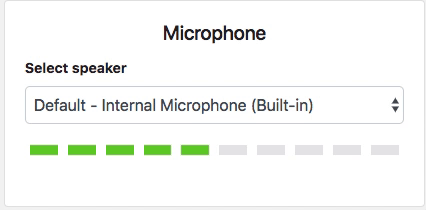Checking Microphone Volume In Javascript
Solution 1:
A slightly more detailed answer after having to work it out myself feel may help others looking here.
This following code will log out a number of approx 0 to 100 based on the microphone volume.
navigator.mediaDevices.getUserMedia({
audio: true,
video: true
})
.then(function(stream) {
const audioContext = newAudioContext();
const analyser = audioContext.createAnalyser();
const microphone = audioContext.createMediaStreamSource(stream);
const scriptProcessor = audioContext.createScriptProcessor(2048, 1, 1);
analyser.smoothingTimeConstant = 0.8;
analyser.fftSize = 1024;
microphone.connect(analyser);
analyser.connect(scriptProcessor);
scriptProcessor.connect(audioContext.destination);
scriptProcessor.onaudioprocess = function() {
const array = newUint8Array(analyser.frequencyBinCount);
analyser.getByteFrequencyData(array);
const arraySum = array.reduce((a, value) => a + value, 0);
const average = arraySum / array.length;
console.log(Math.round(average));
// colorPids(average);
};
})
.catch(function(err) {
/* handle the error */console.error(err);
});
If you have this number jquery to style blocks of color. An example function of this i have provided below but that is the easy part. Just un-comment out the color pids function.
functioncolorPids(vol) {
const allPids = [...document.querySelectorAll('.pid')];
const numberOfPidsToColor = Math.round(vol / 10);
const pidsToColor = allPids.slice(0, numberOfPidsToColor);
for (const pid of allPids) {
pid.style.backgroundColor = "#e6e7e8";
}
for (const pid of pidsToColor) {
// console.log(pid[i]);
pid.style.backgroundColor = "#69ce2b";
}
}
To make sure this answer is as detailed as possible i have also attached my html and css below so you can just copy the js html and css if you wish to get a working example up and running.
html:
<divclass="pids-wrapper"><divclass="pid"></div><divclass="pid"></div><divclass="pid"></div><divclass="pid"></div><divclass="pid"></div><divclass="pid"></div><divclass="pid"></div><divclass="pid"></div><divclass="pid"></div><divclass="pid"></div></div>css:
.pids-wrapper{
width: 100%;
}
.pid{
width: calc(10% - 10px);
height: 10px;
display: inline-block;
margin: 5px;
}
Solution 2:
Here is an answer simply using setTimeout instead of the deprecated createScriptProcessor function:
(async () => {
let volumeCallback = null;
let volumeInterval = null;
const volumeVisualizer = document.getElementById('volume-visualizer');
const startButton = document.getElementById('start');
const stopButton = document.getElementById('stop');
// Initializetry {
const audioStream = await navigator.mediaDevices.getUserMedia({
audio: {
echoCancellation: true
}
});
const audioContext = newAudioContext();
const audioSource = audioContext.createMediaStreamSource(audioStream);
const analyser = audioContext.createAnalyser();
analyser.fftSize = 512;
analyser.minDecibels = -127;
analyser.maxDecibels = 0;
analyser.smoothingTimeConstant = 0.4;
audioSource.connect(analyser);
const volumes = newUint8Array(analyser.frequencyBinCount);
volumeCallback = () => {
analyser.getByteFrequencyData(volumes);
let volumeSum = 0;
for(const volume of volumes)
volumeSum += volume;
const averageVolume = volumeSum / volumes.length;
// Value range: 127 = analyser.maxDecibels - analyser.minDecibels;
volumeVisualizer.style.setProperty('--volume', (averageVolume * 100 / 127) + '%');
};
} catch(e) {
console.error('Failed to initialize volume visualizer, simulating instead...', e);
// Simulation//TODO remove in production!let lastVolume = 50;
volumeCallback = () => {
const volume = Math.min(Math.max(Math.random() * 100, 0.8 * lastVolume), 1.2 * lastVolume);
lastVolume = volume;
volumeVisualizer.style.setProperty('--volume', volume + '%');
};
}
// Use
startButton.addEventListener('click', () => {
// Updating every 100ms (should be same as CSS transition speed)if(volumeCallback !== null && volumeInterval === null)
volumeInterval = setInterval(volumeCallback, 100);
});
stopButton.addEventListener('click', () => {
if(volumeInterval !== null) {
clearInterval(volumeInterval);
volumeInterval = null;
}
});
})();div {
--volume: 0%;
position: relative;
width: 200px;
height: 20px;
margin: 50px;
background-color: #DDD;
}
div::before {
content: '';
position: absolute;
top: 0;
bottom: 0;
left: 0;
width: var(--volume);
background-color: green;
transition: width 100ms linear;
}
button {
margin-left: 50px;
}
h3 {
margin: 20px;
font-family: sans-serif;
}<h3><b>NOTE:</b> This is not accurate on stackoverflow, since microphone use is not permitted. It's a simulation instead.</h3><divid="volume-visualizer"></div><buttonid="start">Start</button><buttonid="stop">Stop</button>This also means, that it can easily be started and stopped on demand.
Solution 3:
Here is the snippet needed to detect audio controls are available (pulled from: https://developer.mozilla.org/en-US/docs/Web/API/Navigator/getUserMedia)
navigator.getUserMedia(constraints, successCallback, errorCallback);
Here is a sample using the getUserMedia function that will enable you access to the microphone.
navigator.getUserMedia = navigator.getUserMedia ||
navigator.webkitGetUserMedia ||
navigator.mozGetUserMedia;
if (navigator.getUserMedia) {
navigator.getUserMedia({ audio: true, video: { width: 1280, height: 720 } },
function(stream) {
console.log("Accessed the Microphone");
},
function(err) {
console.log("The following error occured: " + err.name);
}
);
} else {
console.log("getUserMedia not supported");
}
Here is a repository that demonstrates the "input volume" you desire.
Solution 4:
Simple Microphone Vu Meter See https://codepen.io/www-0av-com/pen/jxzxEX
Checked and working in 2018, including bug fix caused by security update in Chrome browser.
HTML
<h3>VU meter from mic input (getUserMedia API)</h3>
<button onclick="startr();" title="click start needed as security in browser increased and voice mic can only be started from a gesture on page">Start</button>
<canvas id="canvas" width="150" height="300" style='background:blue'></canvas>
<br>
CLICK START
<div align=left>See JS for attribution</div>
CSS
body {
color: #888;
background: #262626;
margin: 0;
padding: 40px;
text-align: center;
font-family: "helvetica Neue", Helvetica, Arial, sans-serif;
}
#canvas {
width: 150px;
height: 100px;
position: absolute;
top: 150px;
left: 45%;
text-align: center;
}
JS (needs JQuery)
// Courtesy www/0AV.com, LGPL license or as set by forked host, Travis Holliday, https://codepen.io/travisholliday/pen/gyaJk functionstartr(){
console.log ("starting...");
navigator.getUserMedia = navigator.getUserMedia ||
navigator.webkitGetUserMedia ||
navigator.mozGetUserMedia;
if (navigator.getUserMedia) {
navigator.getUserMedia({
audio: true
},
function(stream) {
audioContext = newAudioContext();
analyser = audioContext.createAnalyser();
microphone = audioContext.createMediaStreamSource(stream);
javascriptNode = audioContext.createScriptProcessor(2048, 1, 1);
analyser.smoothingTimeConstant = 0.8;
analyser.fftSize = 1024;
microphone.connect(analyser);
analyser.connect(javascriptNode);
javascriptNode.connect(audioContext.destination);
canvasContext = $("#canvas")[0].getContext("2d");
javascriptNode.onaudioprocess = function() {
var array = newUint8Array(analyser.frequencyBinCount);
analyser.getByteFrequencyData(array);
var values = 0;
var length = array.length;
for (var i = 0; i < length; i++) {
values += (array[i]);
}
var average = values / length;
// console.log(Math.round(average - 40));
canvasContext.clearRect(0, 0, 150, 300);
canvasContext.fillStyle = '#BadA55';
canvasContext.fillRect(0, 300 - average, 150, 300);
canvasContext.fillStyle = '#262626';
canvasContext.font = "48px impact";
canvasContext.fillText(Math.round(average - 40), -2, 300);
// console.log (average);
} // end fn stream
},
function(err) {
console.log("The following error occured: " + err.name)
});
} else {
console.log("getUserMedia not supported");
}
}

Post a Comment for "Checking Microphone Volume In Javascript"